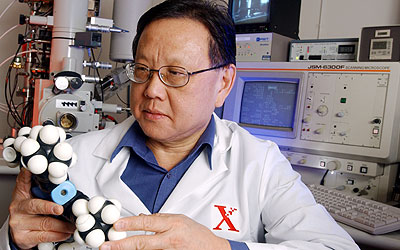
Semiconductive ink and new materials revealed today by Xerox may make flexible roll-up television screens and computer displays one step closer to reality.
According to Xerox, it has developed a high-performance, semiconductive ink that can be used to print the semiconductor channels of transistors at low temperatures and in open air - a requirement for low-cost manufacturing. Most materials developed by researchers from other organizations have required processing at high temperatures and under inert atmospheres.
In addition to creating the semiconductive ink necessary to print the semiconductor component of a transistor circuit, Beng Ong, a Xerox fellow, reported today that his team at the Xerox Research Centre of Canada has also developed materials for printing the conductor and the dielectric components. Thus, all three elements necessary to make a plastic circuit - a semiconductor, a conductor and dielectric - may now be printed using inkjet techniques.
Companies worldwide have been competing to develop a low-cost alternative to silicon technology that could print flexible plastic transistors as easily as printing a newspaper. The technology could ultimately lead to inexpensive large-area devices like flat-panel and flexible displays and low-end microelectronics such as radio frequency identification tags.
The Holy Grail for researchers who want to bring flexible plastic circuits to the masses is a low-cost manufacturing solution that has two key elements: one, materials that can be processed in ambient conditions, and two, compatible printing techniques. The research developments announced today could satisfy both these manufacturing requirements.
According to Ong, if progress continues on this research project as he expects, Xerox just may have found the missing elements that could enable commercialized applications of flexible printed transistors. Ong discussed these research findings in a presentation at the Materials Research Society spring conference here today.
"Having developed these three critical liquid-processable materials may make it possible to create low-cost, flexible plastic transistor circuits using common liquid-deposition techniques such as spin coating, screen or stencil printing, offset, or inkjet printing," Ong said. He believes that products based on these or similar materials will be available commercially in the near future.
Xerox's advances build on the unique polythiophene semiconductor previously designed by Ong's team at XRCC, as well as on the Palo Alto Research Center's method for creating a plastic semiconductor transistor array using inkjet printing, reported last fall. PARC is a wholly owned subsidiary of Xerox.
Being able to print in open air is significant because the electrical properties of most liquid-processable organic semiconductors degrade when exposed to atmospheric oxygen. This makes it difficult to build functional transistors in air. However, the Xerox polythiophene semiconductor not only possesses better air stability, but also exhibits excellent self assembly behavior.
Its unique molecular characteristics allow it to be readily processed into novel, structurally ordered semiconductor nanoparticles. These nanoparticles, when dispersed in a liquid, form environmentally stable nanoparticle ink. The ink provides consistent properties and enables inkjet printing of high-performing organic transistor channel layers under ambient conditions for the first time.
Under a National Institute of Standards and Technology's Advanced Technology Program grant, Xerox is working with Motorola Inc. and Dow Chemical Company in developing plastic integrated circuits for various electronic applications. Using XRCC's materials, PARC is inkjet printing active-matrix addressed arrays as backplane switching circuits for displays, while Motorola is fabricating plastic circuits for various applications using commercial printing technologies.
"Without the sharing of financial burden through the ATP grant, Xerox would not have been able to aggressively pursue this high-risk research endeavor," said Herve Gallaire, president, Xerox Innovation Group, and the company's chief technology officer. "The ATP grant has dramatically accelerated the progress of this research, leading to our profound materials and process developments for this emerging technology."
Xerox innovation includes work in color science, computing, digital imaging, work practices, electromechanical systems, novel materials, and other disciplines connected to Xerox's expertise in printing and document management.
Photo by Greig Reekie